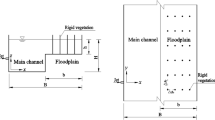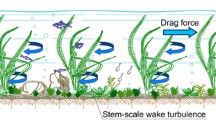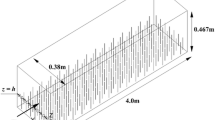Abstract
Vegetation plays an important role on the turbulence structures of the effluent spreading in an open channel, which are insufficiently studied. This paper employs a large eddy simulation model to investigate the hydrodynamic processes of a round jet in a vegetated crossflow. The time-averaged simulated results are consistent with the experimental data. Analyses of mean flow characteristics including velocity distributions in different planes are showed that the array of rigid vegetation affects the averaged flow field and the jet structure, diminishing the velocity, with a significant increase of the jet penetration height. Moreover, this simulation successfully reproduces the coherent structures of classical and well-documented types based on the mean and instantaneous flow fields, including shear-layer vortices, wake vortices, counter-rotating vortex pair and windward vortex pair. The momentum transport mechanism is quantitatively elaborated by the quadrant analysis. Spectral analysis is adopted to obtain the dominant frequencies of vortex shedding and investigated the characteristic length of the large-scale vortex at different probes in the flow field.














Similar content being viewed by others
References
Kamotani Y, Greber I (1972) Experiments on a turbulent jet in a cross flow. AIAA J 30(11):1425–1429. https://doi.org/10.2514/3.50386
Lam KN, Chan HC (1997) Round jet in a ambient counterflowing stream. J Hydraul Eng 123(10):895–903. https://doi.org/10.1061/(ASCE)0733-9429(1997)123:10(895)
de Wit L, van Rhee C, Keetels G (2014) Turbulent interaction of a buoyant jet with cross-flow. J Hydraul Eng 140(12):04014060-1-14. https://doi.org/10.1061/(asce)hy.1943-7900.0000935
Gao N, Ewing D (2015) Large-scale flow structures in a planar offset attaching jet with a co-flowing wall jet. J Turbul 16(3):290–308. https://doi.org/10.1080/14685248.2014.986330
Mossa M, Serio FD (2016) Rethinking the process of detrainment: jets in obstructed natural flows. Sci Rep 6(39103):1–11. https://doi.org/10.1038/srep39103
Wright SJ (1977) Effects of ambient crossflows and density stratification on the characteristic behavior of round turbulent buoyant jets. California Institute of Technology, Pasadena
Lee JHW (1984) Boundary effects on a submerged jet group. J Hydraul Res 122(1):19–29. https://doi.org/10.1080/00221688409499379
Quinn WR (2006) Upstream nozzle shaping effects on near field flow in round turbulent free jets. Eur J Mech B Fluid 25:279–301. https://doi.org/10.1016/j.euromechflu.2005.10.002
Yu D, Ali MS, Lee JHW (2006) Multiple tandem jets in cross-flow. J Hydraul Eng 132(9):971–982. https://doi.org/10.1061/(ASCE)0733-9429(2006)132:9(971)
Zeng YH, Huai WX (2008) Characteristics of round thermal discharging in a flowing environment. J Hydro-Environ Res 2:164–171. https://doi.org/10.1061/(ASCE)0733-9429(2006)132:9(971)
Li ZW, Huai WX, Qian ZD (2012) Study on the flow field and concentration characteristics of the multiple tandem jets in crossflow. Sci China Technol Sci 55(10):2778–2788. https://doi.org/10.1007/s11431-012-4964-9
Gao M, Huai WX, Li YT, Wang WJ (2017) Numerical study of the flow and dilution behaviors of round buoyant jet in counterflow. J Hydrodyn 29(1):172–175. https://doi.org/10.1016/S1001-6058(16)60729-1
Ghisalberti M, Nepf HM (2005) Mass transport in vegetated shear flows. Environ Fluid Mech 5:527–551. https://doi.org/10.1007/s10652-005-0419-1
Tanino Y, Nepf HM (2008) Laboratory investigation of mean drag in a random array of rigid, emergent cylinders. J Hydraul Eng 134(1):34–41. https://doi.org/10.1061/(ASCE)0733-9429(2008)134:1(34)
Huai WX, Gao M, Zeng YH, Li D (2009) Two-dimensional analytical solution for compound channel flows with vegetated floodplains. Appl Math Mech 30(9):1121–1130. https://doi.org/10.1007/s10483-009-0906-z
Nepf HM (2012) Hydrodynamics of vegetated channels. J Hydraul Res 50(3):262–279. https://doi.org/10.1080/00221686.2012.696559
Gambi MC, Noewell ARM, Jumars PA (1990) Flume observations on flow dynamics in Zostera marina (eelgrass) beds. Mar Ecol Prog Ser 61:159–169. https://doi.org/10.3354/meps061159
Leonard L, Luther M (1995) Flow hydrodynamics in tidal marsh canopies. Limnol Oceanogr 40:1474–1484. https://doi.org/10.4319/lo.1995.40.8.1474
Nepf HM, Sullivan JA, Zavistoski RA (1997) A model for diffusion within an emergent vegetation. Limnol Oceanogr 42(8):85–95. https://doi.org/10.4319/lo.1997.42.8.1735
Augustion LN, Irish JL, Lynett P (2009) Laboratory and numerical studies of wave damping by emergent and near-emergent wetland vegetation. Coast Eng 56:332–340. https://doi.org/10.1016/j.coastaleng.2008.09.004
Liu D, Diplas P, Hodges CC, Fairbanks JD (2010) Hydrodynamics of flow through double layer rigid vegetation. Geomorphology 116:286–296. https://doi.org/10.1016/j.geomorph.2009.11.024
Chen SC, Kuo YM, Li YH (2011) Flow characteristics within different configurations of submerged flexible vegetation. J Hydrol 398:124–134. https://doi.org/10.1016/j.jhydrol.2010.12.018
Li CW, Xie JF (2011) Numerical modeling of free surface flow over submerged and highly flexible vegetation. Adv Water Resour 34:468–477. https://doi.org/10.1016/j.advwatres.2011.01.002
Huai WX, Li CG (2016) Longitudinal dispersion in open channel flow with suspended canopies. Water Sci Technol 74(3):722–728. https://doi.org/10.2166/wst.2016.236
Zhao F, Huai WX, Li D (2017) Numerical modeling of open channel flow with suspended canopy. Adv Water Resour 105:132–143. https://doi.org/10.1016/j.advwatres.2017.05.001
Fairbanks JD (1998) Velocity and turbulence characteristics in flows through rigid vegetation. Dissertation, Virginia Polytechnic Institute & State University
Ghisalberti M, Nepf HM (2002) Mixing layers and coherent structures in vegetated aquatic flows. J Geophys Res 107(C2):3011. https://doi.org/10.1029/2001JC000871
Huai WX, Zeng YH, Xu ZG, Yang ZH (2009) Three-layer model for vertical velocity distribution in open channel flow with submerged rigid vegetation. Adv Water Resour 32:487–492. https://doi.org/10.1016/j.advwatres.2008.11.014
Nepf HM, Vivoni ER (2000) Flow structure in depth-limited, vegetated flow. J Geophys Res 105:28547–28557. https://doi.org/10.1029/2000JC900145
Nepf HM, Ghisalberti M (2008) Flow and transport in channels with submerged vegetation. Acta Geophys 56(3):753–777. https://doi.org/10.2478/s11600-008-0017-y
Ben Meftah M, Serio FD, Malcangio D, Mossa M, Petrillo AF (2015) Experimental study of a vertical jet in a vegetated crossflow. J Environ Manag 164:19–31. https://doi.org/10.1016/j.jenvman.2015.08.035
Malcangio D, Mossa M (2016) A laboratory investigation into the influence of a rigid vegetation on the evolution of a round turbulent jet discharged within a cross flow. J Environ Manag 173:105–120. https://doi.org/10.1016/j.jenvman.2016.02.044
Mary I, Sagaut P (2002) Large eddy simulation of flow around an airfoil near stall. AIAA J 40(6):1139–1145. https://doi.org/10.2514/2.1763
Huai WX, Wu ZL, Qian ZD, Geng C (2011) Large eddy simulation of open channel flows with non-submerged vegetation. J Hydrodyn 23(2):258–264. https://doi.org/10.1016/S1001-6058(10)60111-4
Malaspinas O, Sagaut P (2014) Wall model for large-eddy simulation based on the lattice Boltzmann method. J Comput Phys 275:25–40. https://doi.org/10.1016/j.jcp.2014.06.020
Zhan JM, Hu WQ, Cai WH, Gong YJ, Li CW (2017) Numerical simulation of flow through circular array of cylinders using porous media approach with non-constant local inertial resistance coefficient. J Hydrodyn 29(1):168–171. https://doi.org/10.1016/S1001-6058(16)60728-X
Hwang RR, Chiang TP, Yang WC (1995) Effect of ambient stratification on buoyant jets in cross-flow. J Eng Mech 121(8):865–872. https://doi.org/10.1061/(ASCE)0733-9399(1995)121:8(865)
Huai WX, Li ZW, Qian ZD, Zeng YH, Han J, Peng WQ (2010) Numerical simulation of horizontal buoyant wall jet. J Hydrodyn 22(1):58–65. https://doi.org/10.1016/S1001-6058(09)60028-7
Naot D, Nezu I, Nakagawa H (1996) Hydrodynamic behavior of partly vegetated open channels. J Hydraul Eng 122:625–633. https://doi.org/10.1061/(ASCE)0733-9429(1996)122:11(625)
Choi SU, Kang HS (2004) Reynolds stress modeling of vegetated open-channel flows. J Hydraul Res 42(1):3–11. https://doi.org/10.1080/00221686.2004.9641178
Yuan LL, Street RL (1998) Trajectory and entrainment of a round jet in crossflow. Phys Fluids 10(9):2324–2335. https://doi.org/10.1063/1.869751
Prière C, Gicquel LYM, Kaufmann P, Krebs W, Poinsot T (2004) Large eddy simulation predictions of mixing enhancement for jets in cross-flows. J Turbul 5(5):1–24. https://doi.org/10.1088/1468-5248/5/1/005
Li ZW, Huai WX, Han J (2011) Large eddy simulation of the interaction between wall jet and offset jet. J Hydrodyn 23(5):544–553. https://doi.org/10.1016/S1001-6058(10)60148-5
Huai WX, Xue WY, Qian ZD (2015) Large-eddy simulation of turbulent rectangular open-channel flow with an emergent rigid vegetation patch. Adv Water Resour 80:30–42. https://doi.org/10.1016/j.advwatres.2015.03.006
Zhang S, Jiang BX, Law AWK, Zhao B (2015) Large eddy simulations of 45° inclined dense jet. Environ Fluid Mech 16:101–121. https://doi.org/10.1007/s10652-015-9415-2
Zhao F, Huai WX (2016) Hydrodynamics of discontinuous rigid submerged vegetation patches in open-channel flow. J Hydro-Environ Res 12:148–160. https://doi.org/10.1016/j.jher.2016.05.004
Yuan LL, Street RL, Ferziger JH (1999) Large eddy simulations of a round jet in crossflow. J Fluid Mech 379:71–104. https://doi.org/10.1017/S0022112098003346
Lim TT, New TH, Luo SC (2001) On the development of large-scale structures of a jet normal to a cross flow. Phys Fluids 13(3):770–775. https://doi.org/10.1063/1.1347960
Ziefle J, Kleiser L (2009) Large eddy simulation of a round jet in crossflow. AIAA J 47(5):1158–1172. https://doi.org/10.2514/1.38465
Kawai S, Lele SK (2010) Large-eddy simulation of jet mixing in supersonic crossflows. AIAA J 48(9):2063–2083. https://doi.org/10.2514/1.J050282
Sakai E, Takahashi T, Watanabe H (2014) Large-eddy simulation of an inclined round jet issuing into a crossflow. Int J Heat Mass Transf 69:300–311. https://doi.org/10.1016/j.ijheatmasstransfer.2013.10.027
Okamoto T, Nezu I (2010) Large eddy simulation of 3-D flow structure and mass transport in open-channel flows with submerged vegetations. J Hydro-Environ Res 4:185–197. https://doi.org/10.1016/j.jher.2010.04.015
Cui J, Neary VS (2008) LES study of turbulent flows with submerged vegetation. J Hydraul Res 46(3):307–316. https://doi.org/10.3826/jhr.2008.3129
Stoesser T, Kim SJ, Diplas P (2010) Turbulent flow through idealized emergent vegetation. J Hydraul Eng 136(12):1003–1017. https://doi.org/10.1061/(ASCE)HY.1943-7900.0000153
Lu J, Dai HC (2016) Effect of submerged vegetation on solute transport in an open channel using large eddy simulation. Adv Water Resour 97:87–99. https://doi.org/10.1016/j.advwatres.2016.09.003
Lu J, Dai HC (2016) Large eddy simulation of flow and mass exchange in an embayment with or without vegetation. Appl Math Model 40:7751–7767. https://doi.org/10.1016/j.apm.2016.03.026
Wang FJ (2004) Computational fluid dynamics analysis-theory and application of CFD software. Tsinghua University Press, Beijing
Smagorinsky J (1963) General circulation experiments with the primitive equations: I. The basic experiment. Mon Weather Rev 91(3):99–164. https://doi.org/10.1175/1520-0493(1963)091<0099:GCEWTP>2.3.CO;2
Germano M, Piomelli U, Moin P, Cabot WH (1991) A dynamic subgrid-scale eddy viscosity model. Phys Fluids A Fluid 3(7):1760–1765. https://doi.org/10.1063/1.857955
Lilly DK (1992) A proposed modification of the Germano subgrid-scale closure method. Phys Fluids A Fluid 4(3):633–635. https://doi.org/10.1063/1.858280
Etminan V, Lowe RJ, Ghisalberti M (2017) A new model for predicting the drag exerted by vegetation canopies. Water Resour Res 53:3179–3196. https://doi.org/10.1002/2016WR020090
Stoesser T, Salvador GP, Rodi W, Diplas P (2009) Large eddy simulation of turbulent flow through submerged vegetation. Transp Porous Med 89:347–365. https://doi.org/10.1007/s11242-009-9371-8
Smirnov A, Shi S, Celik I (2001) Random flow generation technique for large eddy simulations and particle-dynamics modeling. J Fluids Eng 123:359–371. https://doi.org/10.1115/1.1369598
Dubief Y, Delcayre F (2000) On coherent-vortex identification in turbulence. J Turbul 1(11):1–22. https://doi.org/10.1088/1468-5248/1/1/011
Kelso RM, Lim TT, Perry AE (1996) An experimental study of round jets in cross-flow. J Fluid Mech 306:111–144. https://doi.org/10.1017/S0022112096001255
New TH, Lim TT, Luo SC (2003) Elliptic jets in cross-flow. J Fluid Mech 494:119–140. https://doi.org/10.1017/S0022112003005925
Ibrahim IM, Murugappan S, Gutmark EJ (2005) Penetration, mixing and turbulent structures of circular and non-circular jets in cross flow. AIAA 2005-300. In: 43rd Aerospace sciences meeting and exhibit conference, Reno. https://doi.org/10.2514/6.2005-300
Genin F, Menon S (2010) Dynamics of sonic jet injection into supersonic crossflow. J Turbul 11(4):1–30. https://doi.org/10.1080/14685240903217813
Willmarth WW, Lu SS (1972) Structure of the Reynolds stress near the wall. J Fluid Mech 55(1):65–92. https://doi.org/10.1017/S0022112072000515
Roshko A (1961) Experiments on the flow past a circular cylinder at very high Reynolds number. J Fluid Mech 10(3):345–356. https://doi.org/10.1017/S002211207200165X
Schlichting H (1979) Boundary-layer theory. McGraw-Hill, New York
Fric TF, Roshko A (1994) Vortical structure in the wake of a transverse jet. J Fluid Mech 279:1–47. https://doi.org/10.1017/S0022112094003800
Rudman M (1996) Simulation of the near field of a jet in a cross flow. Exp Therm Fluid Sci 12(2):134–141. https://doi.org/10.1016/0894-1777(95)00089-5
Cortelezzi L, Karagozian AR (2001) On the formation of the counter-rotating vortex pair in transverse jets. J Fluid Mech 446:347–373. https://doi.org/10.1017/S0022112001005894
Shapiro SR, Closkey RT, Karagozian AR (2006) Optimization of controlled jets in crossflow. AIAA J 44(6):1292–1298. https://doi.org/10.2514/1.19457
Acknowledgements
The authors gratefully acknowledge the financial support from National Natural Science Foundation of China (Grant Nos. 11672213, 51439007 and 11372232).
Author information
Authors and Affiliations
Corresponding author
Rights and permissions
About this article
Cite this article
Xiao, Y., Huai, W., Gao, M. et al. Evaluating the hydrodynamics of a round jet in a vegetated crossflow through large eddy simulation. Environ Fluid Mech 19, 181–201 (2019). https://doi.org/10.1007/s10652-018-9605-9
Received:
Accepted:
Published:
Issue Date:
DOI: https://doi.org/10.1007/s10652-018-9605-9




